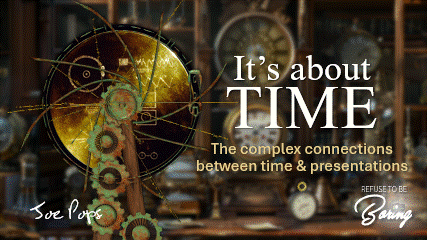 Time is much more important than you think
Time is much more important than you think
We often only think about time in a presentation in relation to how long the presentation is. Without a doubt, this is important. Starting on time and stopping on time sends your audience a critical message. That is: Your time is important to me, therefore, you are important to me. But this is only one perspective on time.
There are at least two presentation “rules” based on time. The 3 second rule is about limiting the text you use on slides to about 3 seconds worth of reading time. Your audience should be able to read everything on your slide in about 3 seconds. The other rule is the 10 minute rule. We lose our ability to keep our attention on a topic after about 10 minutes. So, as a presenter, you have to change up what you are doing every 9.9 minutes.
There is the great presentation myth about the number of slides equalling time. Slide count has nothing to do with time.
You can modify the time factors for all slide transitions and animations. This can affect how an audience perceives the flow of the presentation. The flow of time.
How long a static slide is in front of your audience is important. For example, with virtual presentations, it’s recommended that you change what’s on your audience’s screen every 20 seconds. They lose their attention if they look at a static image for too long a time.
And from a purely rhetorical perspective, there is the use of time in your speaking. You can use a little piece of time, the pause, to add some drama to what comes next.
I’m sure I’ve missed some time related components of a presentation. Can you think of any?
Joe Pops
R2BB
